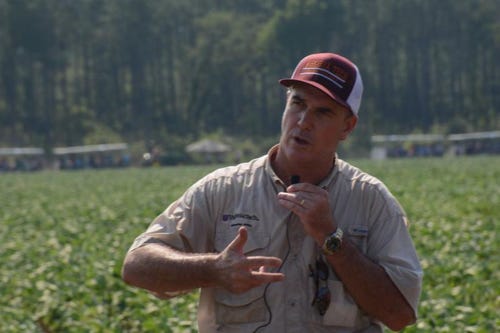
The challenge of double-crop soybean production is yields often don’t keep up with full-season yields.
An initiative was launched two years ago to increase yields in double-crop small grain/soybean systems across the Mid-Atlantic.
During the Northeast Ag Expo field day held at the Lynn Hobbs Farm in Hobbsville, N.C. July 28, David Holshouser, Virginia Tech Extension soybean specialist, said the study is being conducted across Pennsylvania, Maryland, Delaware, Virginia and North Carolina with the aim of improving yields of both soybeans and small grains (either wheat or barley) in a double-crop system.
In the five-state study, six different soybean varieties across different maturity groups are being examined for yield performance. The study includes two late maturity group four varieties, two early maturity group five varieties and two late maturity group five varieties.
Holshouser noted that when wheat yields go down in a double-crop system, soybean yields go down as well. He said research shows soybean yields are best when wheat is harvested at 20 percent moisture. “The most profitable option is to harvest high moisture wheat,” the Virginia Tech specialist said.
Rasel Parvej, a post doctorate research associate at Virginia Tech working on the project with Holshouser, explains that delaying wheat harvest clearly reduces soybean yields in a double-crop system. In last year’s study, wheat was harvested beginning in early June all the way to mid-July in four states. North Carolina joined the project this year.
“We did not see much difference from early June to mid-June, but after that you lose 20 bushels per acre yield if you delay harvest. You are also reducing test weight if you delay harvest. If test weight falls below the market limit, you cannot sell your wheat as food grade. You have to sell it as feed grade and you are paid less,” Parvej said.
The goal is to harvest wheat at 20 percent moisture to deliver the best returns. Parvej said it is critical to get the grain quality number above 300 to receive the maximum return for good quality wheat. “If you delay your harvest, your grain quality number declines and you are paid less,” Parvej stressed.
Delaying soybean planting reduces yields
Delaying soybean planting to after mid-June also reduces soybean yields due to the shortened growing season, Parvej said, stressing that a leaf area index of 3.5 to 4 is for maximum growth and yields which is achieved when the soybean plant captures as much sunlight as possible.
In his comments at the field day, Jim Dunphy, North Carolina State University Extension soybean specialist, also emphasized the importance of a leaf area index of 3.5 to 4 in soybeans in a double-crop system.
“We need to get three and half to four layers of leaves per acre of ground out there. That’s the equivalent of being about 36 inches tall. If we get soybean plants to be 36 inches tall, we probably have a leaf area index of 3.5 to 4,” Dunphy said.
“That’s going to maximize our yield. If we don’t get it big enough to get that leaf area index to 3.5 to 4, we’re giving up yield. One way to help offset it is to go to a later maturing variety not because it’s later maturing but because the late maturity varieties also quit growing later which means they have more days to get big enough. I’m more worried about getting them big enough than anything else on these double crop beans,” Dunphy said. “If we can get that leaf area index to 3.5 to 4, we’re in good shape.”
North Carolina State University joined the Mid-Atlantic study this year and has a double crop test plot on the Hobbs farm. An aim of the North Carolina research is to determine what soybean variety should be used in a double crop system. Dunphy is examining Group Four, Group Five and Group Six varieties.
“If a variety is not going to yield as well as later variety, you have to think twice about it,” Dunphy said. “We don’t have a lot of experience double cropping a group four. We haven’t until recently had group fours that hold up that well in North Carolina. Today, we have group fours that do very well, particularly full season. I’m worried about group four double crop. I’m worried about whether it can get big enough quick enough to get the job done.”

David Holshouser, Virginia Tech Extension soybean specialist, says the goal of the Mid-Atlantic double-crop soybean research initiative is to increase yields and profits in double-crop soybeans in Delaware, Maryland, Pennsylvania, Virginia and North Carolina.
David Holshouser, Virginia Tech Extension soybean specialist, says the goal of the Mid-Atlantic double-crop soybean research initiative is to increase yields and profits in double-crop soybeans in Delaware, Maryland, Pennsylvania, Virginia and North Carolina.About the Author(s)
You May Also Like






